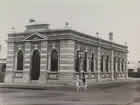Mechanics’ Institutes were important cultural structures in many Victorian towns and cities in the mid 1880s. First established in Melbourne in 1839, the institutes were part of a movement within the British colonies that had started in England in the 1820s, and were premised on the belief that knowledge beyond that required for occupations or required skills was important for moral and intellectual advancement. To achieve this, the institutes held lectures – delivered by artists, doctors, politicians and other notable citizens – for largely working class tradesmen, artisans and mechanics. The institute buildings usually consisted of a library, a reading room, and sometimes a museum; they were available to men for a yearly membership fee. By 1850, there were more than a hundred institutes in Victoria alone.
On the goldfields, the institutions offered an alternate perspective to that generated by gold. They attempted to persuade young men that intellectual pursuits were worthwhile and important, as opposed to the greed and desire for instant wealth that gripped many men. In calling for the establishment of an institute, in May 1853, the Ballarat Star explained that ‘young men of Ballarat have become satiated with the Charles Napier Theatre and the free concerts of the Main Road, the only amusements in Ballarat; they require an institution in which their minds can be improved.’
In February 1855, Castlemaine established a rudimentary Mechanics’ Institute on the corner of Barker and Mechanics Streets. Initially, the institution consisted solely of a library with a table and a scattering of chairs. In this room, twice weekly meetings and lectures were held. In 1857, grander premises were created when the government granted both land and funds. The building not only contained a library, but also a hall, reading room and offices. In the sixties and seventies the Mechanics’ Hall held lectures, public entertainment, meetings, and fetes.
The Ballaarat Mechanics’ Institute, located in Sturt Street, was formed in 1859. In 1860, a lecture hall – designed by the architect Charles Boykett – was created with the capacity to house more than a thousand people. Nine years later the grand facade was completed, together with the front rooms, at a cost of ₤6000. Established to ‘diffuse literary, scientific and other useful knowledge’, the library had an impressive collection of journals, reference books, and other reading material. Lectures, debates, social functions, exhibitions, art classes, and chess games all occurred within its walls. With extensive renovations and additions, the institute, from 1870, included smoking and reading rooms, a library, a museum of mineral specimens, a hall, a lecture theatre, and rent-generating offices.




